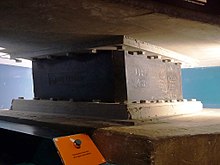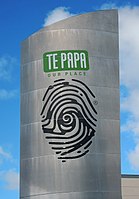Museum of New Zealand Te Papa Tongarewa
The Museum of New Zealand Te Papa Tongarewa , or Te Papa for short , is the National Museum of New Zealand .
Origin of name
The museum's Māori name, Te Papa Tongarewa , is taken from two classical expressions found in Māori poems and songs. Literally translated, the name means something like "container for treasures" , whereby the name can be translated as "our place of treasured things and people that spring from mother earth here in New Zealand" . The short form Te Papa is translated as “Our place” .
geography
The museum is located in Wellington , the country's capital. It is right on the south bank of Lambton Harbor , which is part of Wellington Harbor . The museum can be reached from the north via Aotea Quay , Waterloo Quay , Customhouse Quay , Jervois Quay and Cable Street , on which the museum is located.
history
The forerunner of today's museum was the Colonial Museum , which opened just behind the Parliament Building in 1865 when Wellington became the country's capital and Parliament moved to Wellington . The museum's first director was James Hector , under whom it was given a science- based orientation.
In 1907 the museum was renamed the Dominion Museum and given a broader focus on the concerns of the nation. In 1913 the newly established National Art Gallery was to move into the Dominion Museum building , but it was not until 1936 that both museums were housed in a new building on Buckle Street .
In 1972 the Dominion Museum was renamed the National Museum , but by the 1980s the museum had reached its capacity limits and one had the impression that as a national museum it could no longer reflect the growing diversity of the country's society. With the Museum of New Zealand Te Papa Tongarewa Act 1992 , the legal basis for today's museum was finally laid and construction work began in 1994.
On February 14, 1998, after around four years of construction, the new museum building on Cable Street was officially opened. It united the previous National Museum and the National Art Gallery and wanted to be both the museum of the indigenous people of New Zealand ( Tangata Whenua ) and the place of the people who came together under the Treaty of Waitangi ( Tangata Tiriti ).
In December 2015, the museum celebrated its 150th anniversary since the Colonial Museum was founded in 1865. Since the new museum opened in 2015, around 25 million guests had visited Te Papa .
The building
The earthquake-proof building was designed under the direction of the New Zealand architect Ivan Mercep . The north side of the building facing the harbor was dedicated to the Māori . The walls and facades symbolize nature, the mountains, the lake and the sky. The south side, on the other hand, where the entrance is located, is supposed to reflect the history of European settlement and is dedicated to the Pākehā .
The building , which weighs around 64,000 tons, rests on 152 so-called shock absorbers (dampers), which consist of hard rubber blocks filled with steel plates and a lead core. According to the calculations, they should help the building to withstand a severe earthquake that can occur every 250 years unscathed. The dampers should be able to absorb vibrations of half a meter in all directions. A quake, which statistically can happen every 500 years, the building would be able to withstand, and repairs would probably be necessary. In the event of a severe earthquake, which can occur every 2,000 years, the people in it would still be safe, but the building would then have to be demolished due to serious damage, according to the ideas of the designers. In order to be able to guarantee a stable foundation for the building, the subsoil with a 30-tonne weight was processed up to 50,000 times at the planned locations of the absorbers in order to be able to rule out subsequent settlement problems due to an unstable subsoil.
Around 80,000 m 3 of concrete had to be processed for the 36,000 m 2 exhibition area and six levels building, which was erected on a 2.3 hectare property . The construction project was carried out at the time by the New Zealand company Fletcher Construction , which also managed to complete the work within the specified framework of NZ $ 130 million .
Order of the museum
The Museum of New Zealand Te Papa Tongarewa Act 1992 established that the museum would allow the nation to showcase, research, and maintain the heritage of its cultures and knowledge of the country's nature with the aim of understanding and appreciating its history To enrich the present and to meet the challenges of the future. The law regulated the amalgamation of the National Museum with the National Art Gallery under the umbrella of the Museum of New Zealand Te Papa Tongarewa and legally protected all four names.
Exhibitions
In addition to the permanent exhibitions on Māori culture, the culture of the Pacific Islands, the New Zealand Wars , Gallipoli , settlement history, the Treaty of Waitangi , earthquake protection, nature and science, temporary exhibitions on various topics are regularly organized. The museum also attaches particular importance to education and the transfer of knowledge and, in addition to a specially designed web portal with access to objects from the current exhibitions, also uses digital media in the house in a special way. A blog keeps interested parties informed about the museum's activities.
Photo gallery
- Te Papa - architecture and exhibition
Room with the Treaty of Waitangi
Te Hau-ki-Tūranga wharenui , Māori meeting house in the museum
Web links
- Homepage . Museum of New Zealand Te Papa Tongarewa,accessed April 29, 2018.
- A history of the Museum of New Zealand Te Papa Tongarewa . Ministry for Culture & Heritage,accessed April 29, 2018.
Individual evidence
- ↑ a b c d Our history . Museum of New Zealand Te Papa Tongarewa , accessed April 29, 2018 .
- ^ New Zealand Touring Atlas . 5th edition. Hema Maps , Brisbane 2015, ISBN 978-1-877302-92-3 , pp. Map 112 (English).
- ^ A b c Museum of New Zealand Te Papa Tongarewa Act 1992 . In: New Zealand Legislation . Parliamentary Council Office , April 8, 1992, accessed April 29, 2018 .
- ^ A history of the Museum of New Zealand Te Papa Tongarewa . Ministry for Culture & Heritage , accessed April 29, 2018 .
- ↑ a b c Our building . Museum of New Zealand Te Papa Tongarewa , accessed April 29, 2018 .
- ↑ Te Papa . Fletcher Construction , accessed April 29, 2018 .
- ↑ Collections . Museum of New Zealand Te Papa Tongarewa , accessed April 30, 2018 .
- ^ Statement of Intent . (PDF 1.4 MB) Museum of New Zealand Te Papa Tongarewa , accessed on April 30, 2018 .
- ↑ Te Papa Blog . Museum of New Zealand Te Papa Tongarewa , accessed April 30, 2018 .
Coordinates: 41 ° 17 ′ 25.8 ″ S , 174 ° 46 ′ 54.5 ″ E










